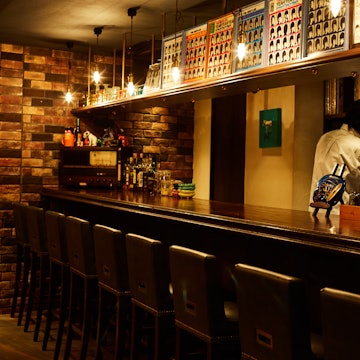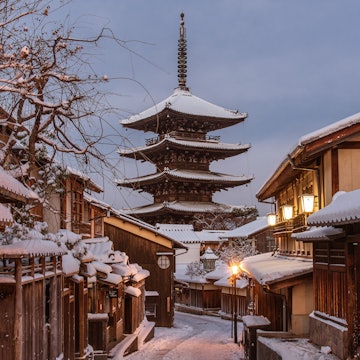
The story of sake in Naruto, Japan is a perfect blend of taste and place
Feb 26, 2021 • 5 min read

Sake adventures abound at the dinner table. Experience rare pairings of sake with cuisine of the world © Naruto Sake Story
In a place very much off the beaten track for Japan travelers is a city linked to our subconscious mind – somewhere we have seen, but cannot easily place. That place is the city of Naruto, located in Tokushima Prefecture on the island region of Shikoku.
You may have seen the ancient wood-block print of the Naruto whirlpools by Utagawa Hiroshige. The image is rough and wild, as sea foam launches over craggy rocks while the water churns below. These Naruto Whirlpool circles are stamped in our minds.

But it is here – in this land where tidal currents swirl, across a bridge that links it to the main island of Honshu, and only a few hours from Osaka and Kyoto – where a unique adventure of sight, sound, and taste come together.
A one-of-a-kind blend
The Naruto Sake Story is a community project spearheaded by Matsuura Sake Brewery of Naruto City, Tokushima. The impetus for this project was born from a deep-seated need to not only share the incredibly rich natural and cultural environs of the region, but also its flavors of food and sake (rice wine), and in the company of the people who live, work, and celebrate life here. Naruto is a warm place, where art, food, sake, people, history, craftsmanship, and spirituality blend. It is here where a special journey to deep Japan can take place.
The story is best understood as a sequence of scenes, contexts where you might find yourself and discover not only the range of subtle and unique flavors of sake in your cup, but also submerse yourself in the cultural and historic mosaic around you.

Near the Matsuura Sake Brewery is Ryouzenji Temple. This is the first temple of 88 that make up the fabled Shikoku Henro Pilgrimage. Pilgrims wearing conical straw hats and clad in white from head to foot begin their long journey from here as they follow in the footsteps of the Buddhist Saint, Kukai. You can hear them chant the Heart Sutra and smell the incense.
The rice grown for sake that is brewed in this story comes by nearby fields, where the water is pristine and the earth is rich. Rice fields are meticulously tended and home to the Oriental stork, called kounotori in Japanese. This beautiful bird was once extinct in Japan, but over the years it has been carefully reintroduced and is now flourishing.
A tradition of craftsmanship
Visitors might also like to try their hand at indigo dyeing, at a local studio. Awa-Ai is the word for the dyed products, and the process of dyeing is called ai-zome. In English it’s known as ‘Japan Blue.’ Or give the potter’s wheel a try and design a unique Japanese treasure at the nearby Otani Pottery Factories. Local masters will guide your hands as you make your own creation.
From whirlpools to temples and holy pilgrimage, to nature and to art, visitors to the Naruto Sake Story may now have their hearts and minds prepared for a journey deep inside the quiet world of sake brewing. It is here where luggage and cares may be put aside, and where you may step into the secret spaces of the Matsuura Sake Brewery and see how this native elixir of Japan is made.

Inside the sake brewery, in the midst of master sake brewers called toji, you can see how the simple rice of the field is transformed into sake in the cup. The rice is carefully milled to perfection, then washed and steamed until it is pristine. Then the rice is ready for the introduction of koji, a fungus known as aspergylus oryzae which can saccharify rice as it breaks down complex carbohydrates (like rice starch) into simple sugars.
From there the sake begins to grow. After a few days, yeasts and spring water are introduced. The yeast produces alcohol, the temperature increases, and bubbles come to the surface. From there the materials are placed in larger vats and water and more rice are added. The sake is mixed and checked frequently. Later comes the pressing, filtration, and lastly, the bottling.
Loving attention
From start to finish, the sake masters of Matsuura Sake Brewery watch their sake grow and take form, and with a maternal love they develop it into a fantastic range of different flavors and textures, complete with a wide palate of smells and aftertastes. Sake brewing is where science and technology meet art, instinct, and intuition. It is both magical and measured, and you are welcome to bear witness with all your senses.
Once you have seen and smelled where and how sake comes into being, you must come and sit at the table and experience the very summit of what a sake adventure is about. Before you will be a range of different cuisines – things you may know, and things you may have only heard of. Sake is best served with many things, and it is here where attention to detail, pauses between mouthfuls, and a moment to breathe in the aromas and flavors are met– sake with sushi and seafood; sake with vegetables and pickles of many sorts; sake with grilled meat; sake with flavors both salty and sour; and sake alone.

And there is more: sake with fruit, with citrus, and even ice cream. Sake is no longer the drink served in thimble sized cups, of old men looking out into a garden from their verandas while wearing kimono. Sake is a delight to the tastebuds that flows through and around an astonishing range of cuisine. It is the perfect companion to dining, and to making new friends from the other side of the world.
This is the Naruto Sake Story.













